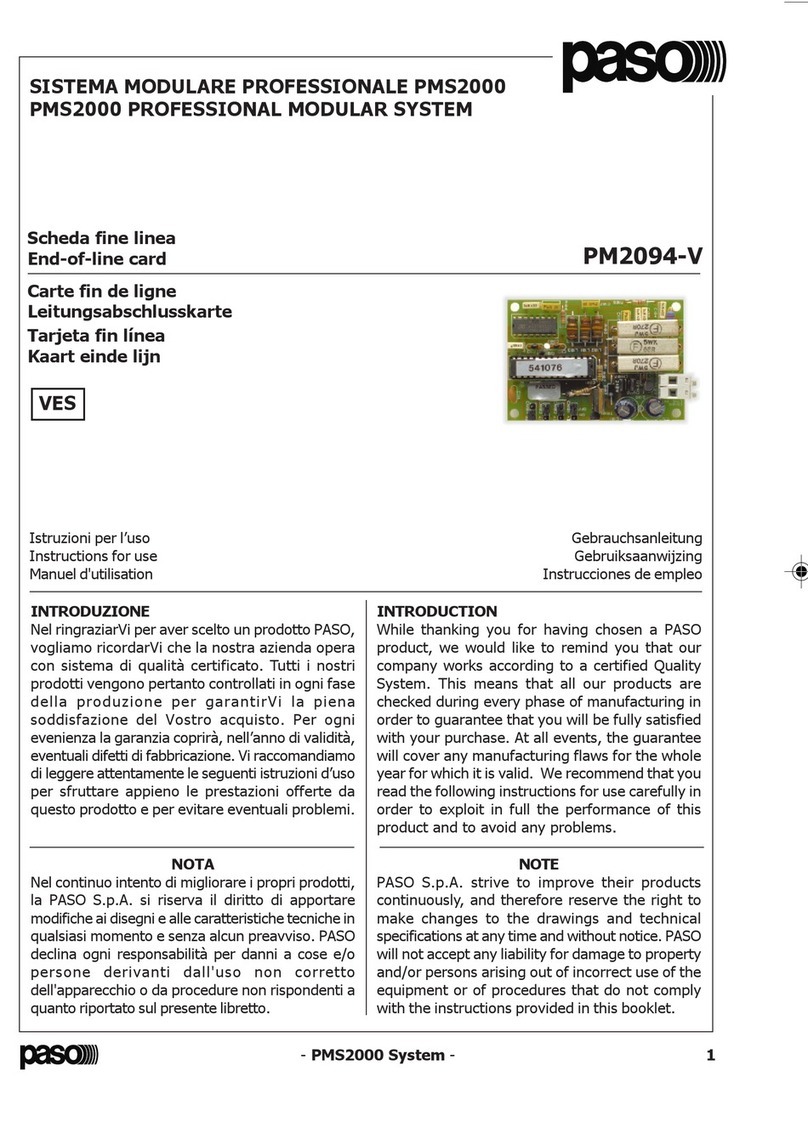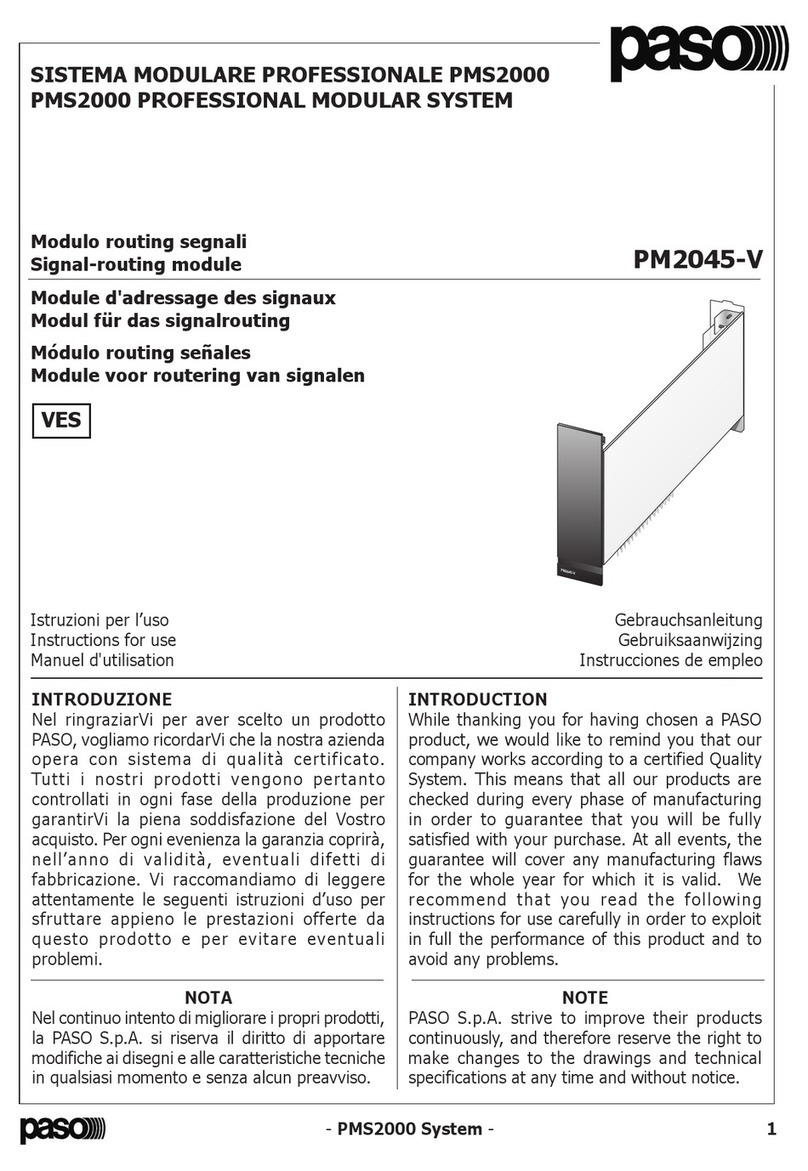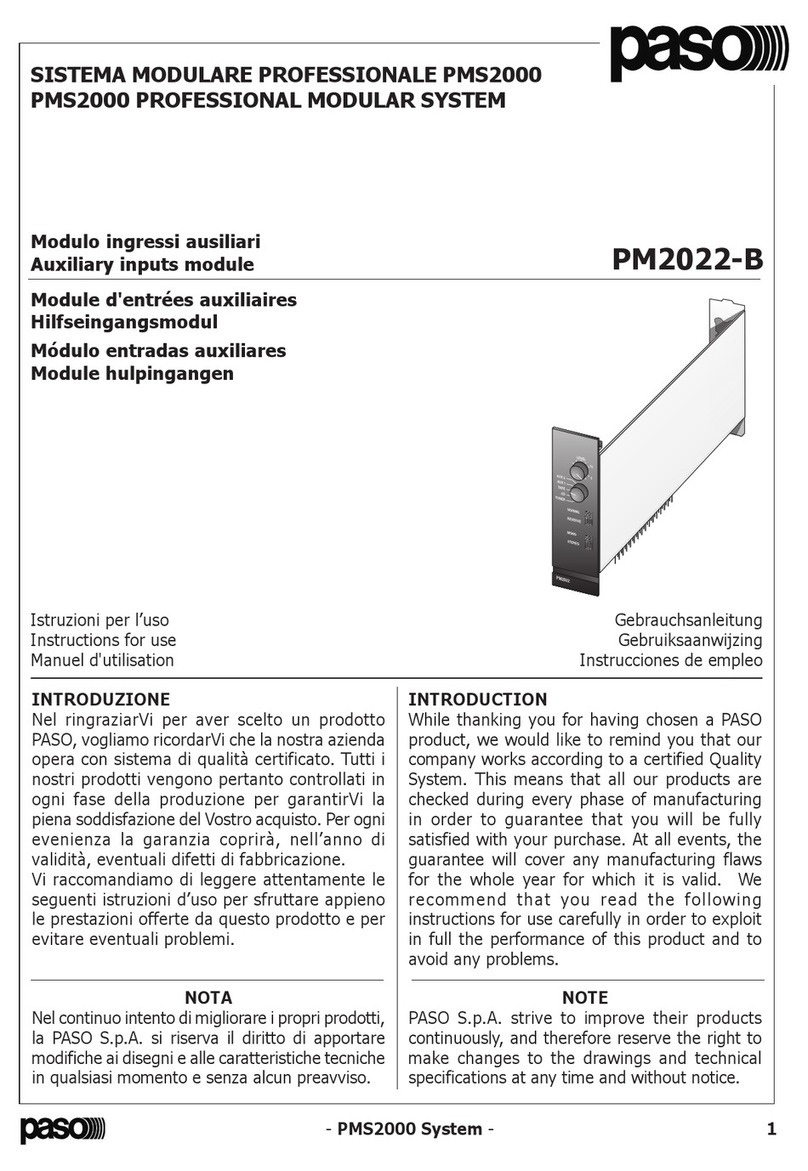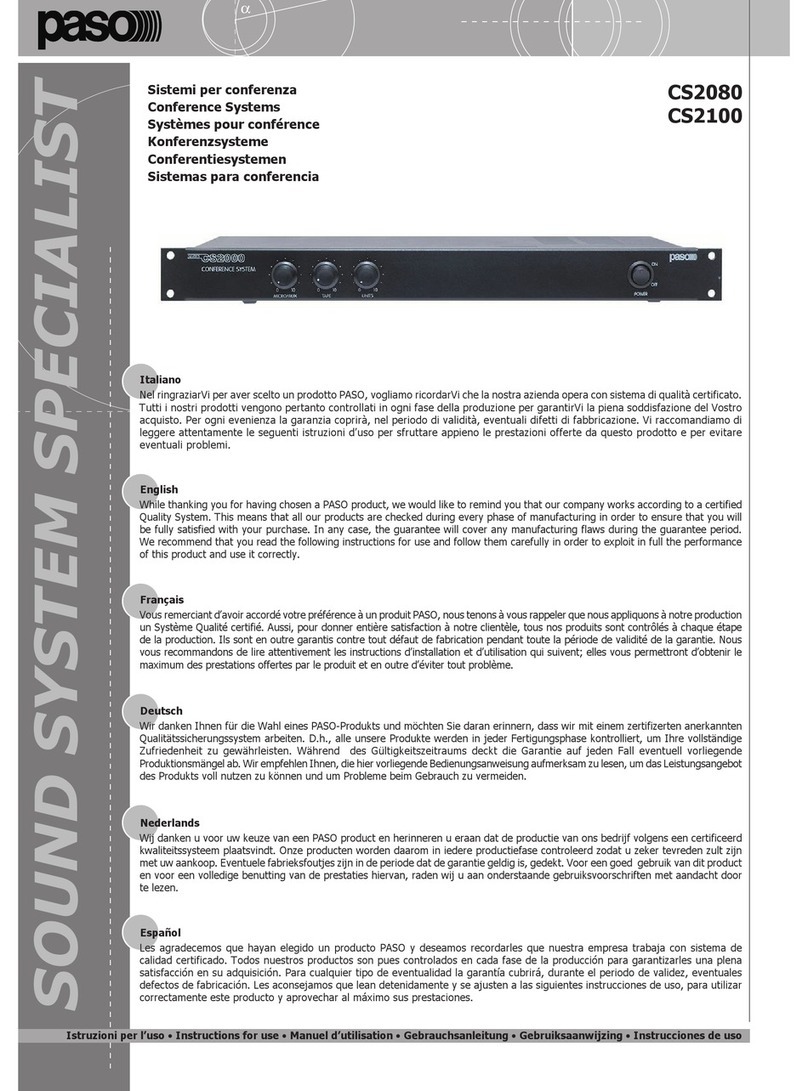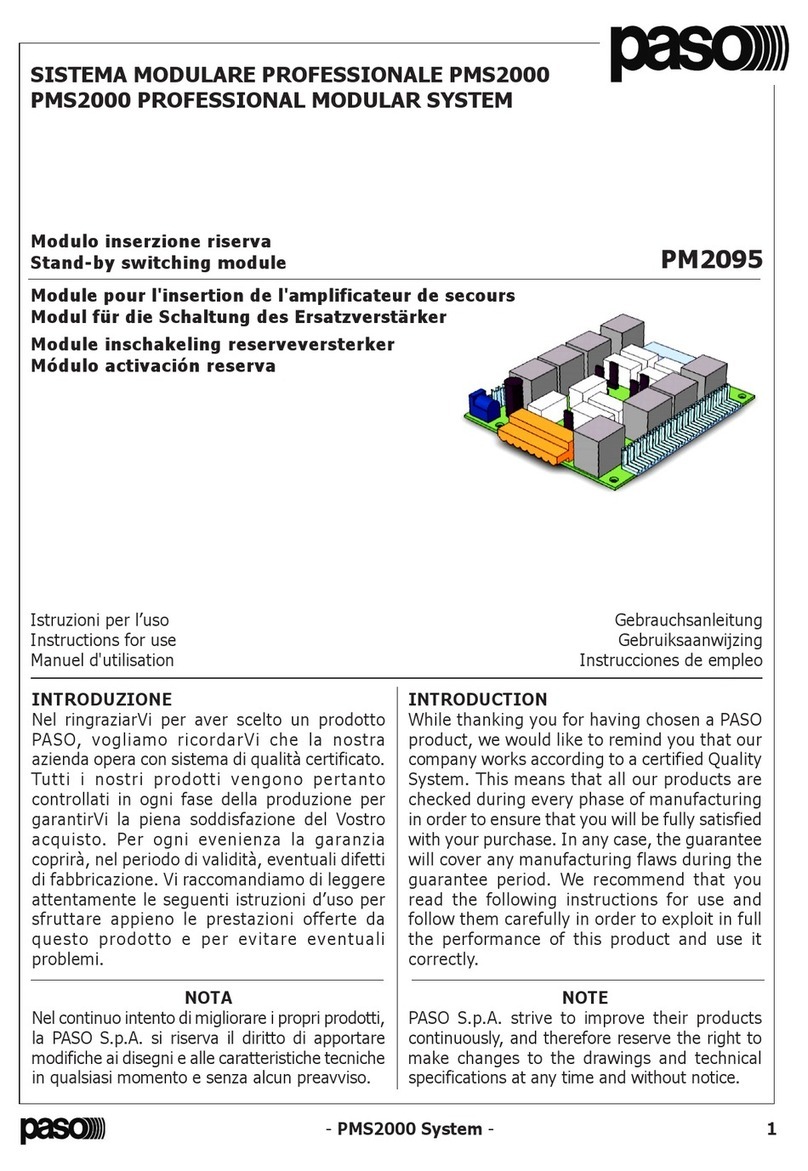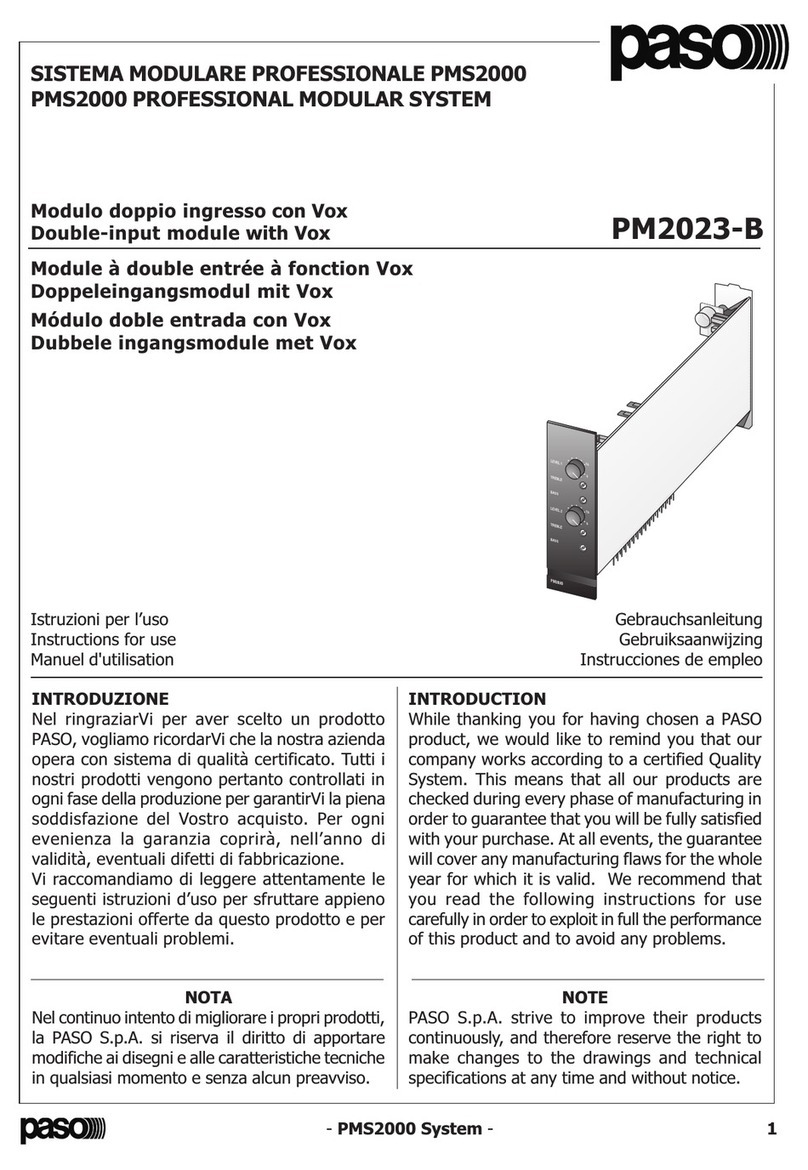- PMS2000 System -
Ref. 11/497-A PM2040-B
9
3.2 Assegnazione delle uscite L/R OUT
Gli stadi di miscelazione secondari (elementi Be
Cdello schema a blocchi di fig. 3.1.1) sono
assegnati di default ai bus dei segnali stereofonici
per mezzo dei due ponticelli inseriti nei connettori
CN105 (
linea destra
) e CN106 (
linea sinistra
).
Questi stadi effettuano, pertanto, la miscelazione
di tutti i segnali immessi su questi bus di
miscelazione. Il segnale ottenuto da questi stadi
sommatori è riportato alle prese di uscita L OUT
[6] (canale sinistro) e R OUT [7] (canale destro).
Rimuovendo i ponticelli dai connettori CN106 e
CN105 gli stadi di miscelazione [B] e [C] vengono
esclusi e le relative uscite [6] e [7] saranno,
pertanto, ammutolite.
NOTA (A): ad ogni linea di miscelazione deve
essere assegnato un solo stadio sommatore,
pertanto, se lo stadio sommatore principale [A],
dello stesso modulo d'uscita o di un'altro installato
nel sistema, viene assegnato ad una delle due
linee di miscelazione stereofoniche si dovrà
provvedere ad escludere lo stadio sommatore
secondario, [B] o [C], normalmente assegnato
a quella linea.
NOTA (B): se nel sistema sono installati più
moduli di uscita sarà necessario rimuovere i
ponticelli dei connettori CN105 e CN106 di tutti
i moduli d'uscita ad esclusione di quello dal quale
si desidera prelevare i segnali dei canali
stereofonici.
3.3 Interruzione del bus PA
Il segnale di uscita dello stadio di miscelazione
principale (elemento "A" dello schema a blocchi
di fig. 3.1.1) è inviato (selezione di default) al
piedino 10 (
uscita bus PA
) del connettore
multivia; tale segnale si presenterà quindi
all'ingresso, piedino 11 (
ingresso bus PA
) del
connettore multivia, dell'eventuale modulo posto
immediatamente a sinistra). Questo segnale può
essere utilizzato per poter disporre, ad esempio,
di più uscite (con relativi controlli di livello e tonalità)
appartenenti allo stesso segnale PA (vedi esempio
al par. 2.5.1). Se non si desidera inviare questo
segnale al modulo successivo (vedi esempio al
par. 2.5.2) è necessario rimuovere il ponticello
posto sul connettore CN104 o lasciare libero il
connettore immediatamente a sinistra di questo
modulo d'uscita.
3.2 Assigning the L and R OUT outputs
The secondary mixing stages (elements Band Cin
the block diagram shown in Figure 3.1.1) are
assigned by default to the busses of the stereo
signals by means of the two jumpers inserted into
connectors CN105 (
right line
) and CN106 (
left
line
). These stages will therefore take care of
the mixing of all the signals input onto these mixing
busses. The signal obtained from these summing
stages is sent to the L OUT [6] (left channel)
and R OUT [7] (right channel) output sockets. If
the jumpers are removed from connectors
CN106 and CN105, then mixing stages [B] and
[C] will be excluded and the associated outputs
[6] and [7] will therefore be muted.
NOTE (A): Only one summing stage has to be
assigned to each mixing line. Therefore, if the
main summing stage [A], of the same output
module or of another installed in the system, is
assigned to one of the two stereo mixing lines,
the secondary summing stage, [B] or [C],
normally assigned to that line, will have to be
excluded.
NOTE (B): If there are several output modules
installed in the system, the jumpers should be
removed from connectors CN105 and CN106
of all the output modules except for the one
from which the signals of the stereo channels
are to be taken.
3.3 Cutting off the PA bus
The output signal from the main mixing stage
(element "A" in the block diagram of Figure 3.1.1)
is sent (default selection) to pin 10 (
PA bus
output
) of the multi-way connector. This signal
will therefore be presented at the input on pin
11 (
PA bus input
) of the multi-way connector,
of the module - if any - positioned immediately
to the left. This signal can be used in order, for
example, to have several outputs at disposal
(with the relevant tone and level controls)
belonging to the same PA signal (see example
under point 2.5.1).
If this signal is not to be sent to the next module
(see example under point 2.5.2), then the jumper
positioned on connector CN104 should be
removed or the connector immediately to the
left of this output module should be left free.
- PMS2000 System -
Ref. 11/497-A PM2040-B
40
La regulación de nivel será efectuada por el
control del procesador externo y por el control
del módulo de entrada, teniendo en cuenta lo
siguiente:
- en el caso de generador de eco/
reverberación, o similares, la señal de salida
directa del módulo de entrada debe estar
configurada como post-fader y el control de
nivel del procesador externo deberá estar
regulado según la cantidad de efecto
deseado.
- en el caso de procesadores antilarsen,
procesadores de dinámica o similares, la señal
de salida directa del módulo de entrada deberá
estar configurada como pre-fader y el control
de nivel del módulo, correspondiente a esa
entrada, deberá estar a cero.
De niveauregeling zal worden uitgevoerd door
de regelaar van de externe processor en door
de regelaar van de ingangsmodule, met
inachtneming van het volgende:
- in het geval van een externe processor, moet
het directe uitgangssignaal van de
ingangsmodule worden ingesteld als post-
fader. De niveauregelaar van de externe
processor moet worden afgesteld op basis
van de hoeveelheid effect die men wil
bereiken.
- in het geval van anti- Larsen processors,
dynamiekprocessors en dergelijke, moet het
directe uitgangssignaal van de ingangsmodule
worden ingesteld als pre-fader en moet
de niveauregelaar van de module van deze
ingang op nul worden gezet.
Ejemplo B:
la señal audio aplicada en esta entrada
(procedente, por ejemplo, de una línea
telefónica) entra directamente en la etapa
sumadora [A] y puede ser empleada como
entrada prioritaria para señalizaciones de
emergencia. Cabe destacar de todas maneras
que las otras señales aplicadas en la etapa
sumadora no son enmudecidas por la señal
aplicada en esta entrada.
Ejemplo C:
empleando una matriz externa de conmutación
audio es posible utilizar esta entrada para
ajustar y balancear las líneas individuales de
salida de la matriz.
4.2 Salida balanceada
La salida BAL. OUT [10], de tipo balanceado y
provista de clavija XLR profesional con gancho
de retención, es considerada como la salida
principal de este módulo; en la fig. 4.2.1 se
indican sus polos.
Voorbeeld B:
het audiosignaal dat verbonden is met deze
ingang (en dat bijvoorbeeld afkomstig is van
een telefoonlijn) komt rechtstreeks in de som-
trap [A] binnen en kan gebruikt worden als
prioriteitsingang. Het is wel zo dat de andere
signalen die verbonden zijn met de som-trap
niet worden onderdrukt (muting) door het
signaal dat met deze ingang is verbonden.
Voorbeeld C:
bij gebruik van een externe audio schakelmatrix
kan deze ingang gebruikt worden voor het
afstellen en balanceren van de afzonderlijke
uitgangslijnen van de matrix.
4.2 Gebalanceerde uitgang
De gebalanceerde uitgang BAL. OUT [10] is
voorzien van een XLR- chassisdeel en is
bedoeld als hoofduitgang van deze module; op
afb. 4.2.1 ziet u de pinconfiguratie van deze
uitgang.
1: blindaje / pantalla
2: señal (lado caliente) / signaal (warme kant)
3: señal (lado frío) / signaal (koude kant)
Fig./Afb. 4.2.1












